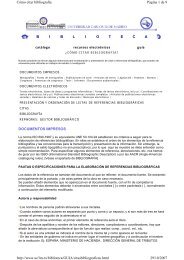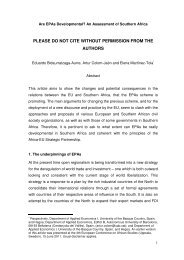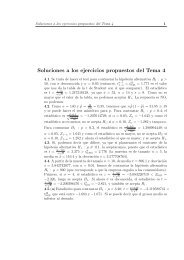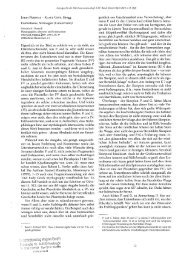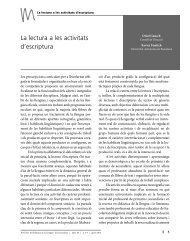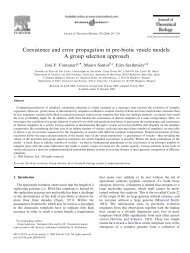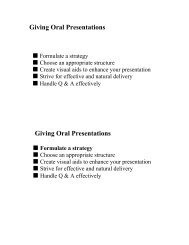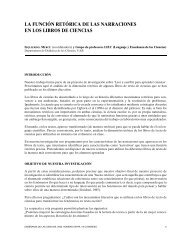Proceedings of the 6th St. Petersburg Workshop on Simulation, June ...
Proceedings of the 6th St. Petersburg Workshop on Simulation, June ...
Proceedings of the 6th St. Petersburg Workshop on Simulation, June ...
You also want an ePaper? Increase the reach of your titles
YUMPU automatically turns print PDFs into web optimized ePapers that Google loves.
83848586878889909192939495Roughly speaking, state space collapse assumpti<strong>on</strong> expresses that any fluidclass k c<strong>on</strong>tributes a fixed porti<strong>on</strong> δ k to <str<strong>on</strong>g>the</str<strong>on</strong>g> workload at stati<strong>on</strong> s(k). That is, <str<strong>on</strong>g>the</str<strong>on</strong>g>fluid classes processed at <str<strong>on</strong>g>the</str<strong>on</strong>g> same stati<strong>on</strong> are mixed in a fixed way in <str<strong>on</strong>g>the</str<strong>on</strong>g> stati<strong>on</strong>’squeue.Remark 1. In <str<strong>on</strong>g>the</str<strong>on</strong>g> particular case K = J, if we assume for c<strong>on</strong>venience (andwithout loss <str<strong>on</strong>g>of</str<strong>on</strong>g> generality) that s(j) = j for any j = 1, . . . , J, <str<strong>on</strong>g>the</str<strong>on</strong>g>n C = I, (7)becomes W = M Z and we trivially obtain state space collapse with regular “lifting”matrix ∆ = M −1 .Now we establish our main result. Recall that we assume ρ < e .Theorem 1. The fluid limit model is stable if verifies state space collapse with aregular “lifting” matrix ∆.The pro<str<strong>on</strong>g>of</str<strong>on</strong>g> <str<strong>on</strong>g>of</str<strong>on</strong>g> <str<strong>on</strong>g>the</str<strong>on</strong>g> <str<strong>on</strong>g>the</str<strong>on</strong>g>orem is based <strong>on</strong> two lemmas formulated below. For <str<strong>on</strong>g>the</str<strong>on</strong>g>sake <str<strong>on</strong>g>of</str<strong>on</strong>g> completeness we introduce a known definiti<strong>on</strong>:Definiti<strong>on</strong> 3 (R-regularizati<strong>on</strong> or Skorokhod problem). Let ˜X be a J−dim.stochastic process with c<strong>on</strong>tinuous paths, defined <strong>on</strong> some probability space, with˜X(0) ≥ 0 , and ˜R a J ×J matrix. We say that <str<strong>on</strong>g>the</str<strong>on</strong>g> pair ( ˜W , Ỹ ) <str<strong>on</strong>g>of</str<strong>on</strong>g> J−dim. stochasticprocesses defined <strong>on</strong> <str<strong>on</strong>g>the</str<strong>on</strong>g> same probability space and with c<strong>on</strong>tinuous paths is asoluti<strong>on</strong> <str<strong>on</strong>g>of</str<strong>on</strong>g> <str<strong>on</strong>g>the</str<strong>on</strong>g> ˜R−Skorokhod problem <str<strong>on</strong>g>of</str<strong>on</strong>g> ˜X in <str<strong>on</strong>g>the</str<strong>on</strong>g> first orthant RJ+ if:˜W (t) ∈ R J + for all t ≥ 0 , ˜W = ˜X + ˜R Ỹ a.s.Ỹ has n<strong>on</strong> − decreasing paths , Ỹ (0) = 0 and for any j, Ỹ j <strong>on</strong>ly increasesif ˜W is <strong>on</strong> face {w ∈ RJ+ : w j = 0} , that is ,∫ ∞0˜W j (t) d Ỹj(t) = 0 .9697Remark 2. Propositi<strong>on</strong> 4.2 [6] shows that c<strong>on</strong>diti<strong>on</strong> (HR) <strong>on</strong> a matrix ˜R issufficient to ensure str<strong>on</strong>g path-wise uniqueness <str<strong>on</strong>g>of</str<strong>on</strong>g> <str<strong>on</strong>g>the</str<strong>on</strong>g> soluti<strong>on</strong>.Lemma 1 (Lemma 5.1 [2]). Assume ρ < e. Let ( ˜W , Ỹ ) be <str<strong>on</strong>g>the</str<strong>on</strong>g> (unique) soluti<strong>on</strong><str<strong>on</strong>g>of</str<strong>on</strong>g> <str<strong>on</strong>g>the</str<strong>on</strong>g> ˜R−Skorokhod problem <strong>on</strong> <str<strong>on</strong>g>the</str<strong>on</strong>g> first orthant <str<strong>on</strong>g>of</str<strong>on</strong>g> a process ˜X, with ˜R verifyingassumpti<strong>on</strong> (HR). If˜W (s) + ˜X(t + s) − ˜X(s) ≥ θ t for all s, t ≥ 0 ,with θ = ˜R 98 (ρ−e), <str<strong>on</strong>g>the</str<strong>on</strong>g>n we have that Ỹ (t+s)−Ỹ (s) ≤ (e−ρ) t for all s, t ≥ 0 , andhence Ỹ ′ (s) ≤ (e − ρ) if Ỹ (·) is differentiable at s and Ỹ ′ 99(·) denotes its derivative.100101102103Lemma 2 (Lemma 5.2 [2]). Let f : [0, +∞) −→ [0, +∞) be a n<strong>on</strong>negativefuncti<strong>on</strong> that is absolutely c<strong>on</strong>tinuous and let κ > 0 be a c<strong>on</strong>stant. Suppose thatfor almost surely (with respect to <str<strong>on</strong>g>the</str<strong>on</strong>g> Lebesgue measure <strong>on</strong> [0, +∞) ) all regularpoints t, f ′ (t) ≤ −κ whenever f(t) > 0. Then f is n<strong>on</strong>increasing and f(t) ≡ 0 fort ≥ f(0)104 κ .Pro<str<strong>on</strong>g>of</str<strong>on</strong>g> <str<strong>on</strong>g>of</str<strong>on</strong>g> Theorem 1: C<strong>on</strong>sider a fluid limit model (α, M, C, P, z) with ρ < e105106and satisfying state space collapse with a regular “lifting” matrix ∆. We want to4





